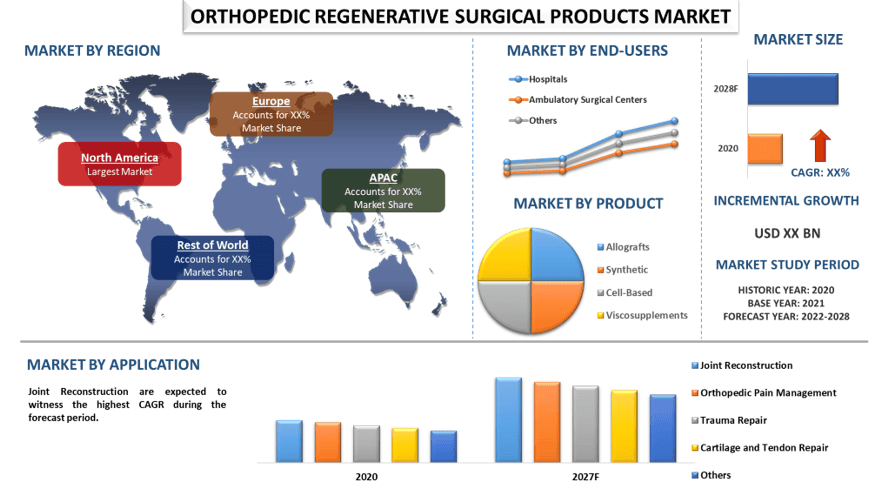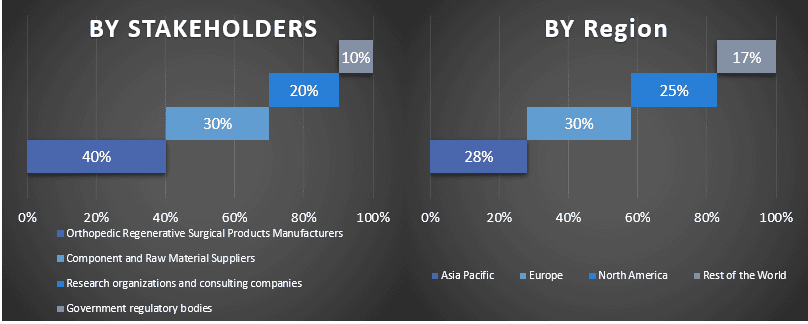- Home
- About Us
- Industry
- Services
- Reading
- Contact Us
Orthopedic Regenerative Surgical Products Market: Current Analysis and Forecast (2022-2028)
Emphasis on Product Type (Allografts, Synthetic, Cell-based, Viscosupplements); Application (Orthopedic Pain Management, Trauma Repair, Cartilage & Tendon Repair, Joint Reconstruction, Others); End-User (Hospitals, Ambulatory Surgical Centers, Others); Region/Country

The orthopedic regenerative surgical products market is expected to register a CAGR of approx. 4% over the period of 2021-2027. Regenerative orthopedics help treat discomfort and pain in the musculoskeletal system and improve the healing of orthopedic conditions, such as ligaments, tendon injuries, muscles, bones, knee meniscus, intervertebral discs life, and cartilage. These parts of the body have a relatively low capacity for self-healing. Regenerative orthopedic surgical products help these tissues heal faster. Orthopedic regenerative surgical products can help some patients avoid orthopedic surgery altogether. The global orthopedic regenerative surgical products market is anticipated to witness an uptick with the growing technological advancement and increased research and development activities for the surgical product. Some other factors which drive the market include the rise in the obese population across the globe. In 2020, according to Trust For America’s Health, the U.S. adult obesity rate stands at 42.4 percent, the first time the national rate has passed the 40 percent mark, and further evidence of the country’s obesity crisis. Owing to these glaring statistics the demand for orthopedic regenerative surgical products is anticipated to grow in the forthcoming years because obesity causes an alteration of bone-regulating hormones, increased oxidative stress and inflammation, and altered bone cell metabolism which damages the bone internally. Furthermore, the increase in the number of trauma repair, orthopedic pain management, joint reconstruction, and cartilage and tendon repair as well as the rising incidences of orthopedic problems such as arthritis and osteoporosis, are expected to drive the market for orthopedic regenerative surgical products market in the coming years.
Some of the major factors such as obesity coupled with the growing healthcare expenditure are propelling the growth of this market in the region. Moreover, an increase in road accident cases also propels the growth of the market. For instance, according to the studies in 2020, One of the factors causing bone fractures is Road Traffic Accidents (RTAs), which are the first leading cause of death among people aged 15-29 years. In 2019, the global number of new cases of fracture was estimated to be 178 million (95%), an increase of 33·4% since 1990. Furthermore, the increasing prevalence of joint reconstruction, growing health care expenditure, and awareness among patients and healthcare are significantly growing the orthopedic regenerative surgical products market.
Anika Therapeutics, Inc., Vericel Corporation, Baxter, Zimmer Biomet, Stryker, Smith & Nephew, AlloSource, Amniox Medical, Inc., VSY Biotechnology, Aptissen S.A. are some of the key players in the market. Several M&As along with partnerships have been undertaken by these players to facilitate customers with hi-tech and innovative products/technologies.
Insights Presented in the Report
“Amongst Product, the viscosupplements category accounted for the majority share in the market in 2020”
Based on product, the market is classified into allografts, synthetic, cell-based, and viscosupplements. Amongst these, the viscosupplement category accounted for a significant share of the market owing to the rising incidence of knee pain, osteoarthritis, and related symptoms and an increase in product availability driving the growth of this segment. Moreover, factors such as aging, obesity, excessive exercise, external injury, and genetic predisposition, further contribute to knee osteoarthritis, thus driving the market for orthopedic regenerative surgical products
“Among Applications, the joint reconstruction is expected to witness highest CAGR during the forecast period”
Based on application, the market is categorized into knee surgeries, hip surgeries, spine surgeries, and others. Among these, knee surgeries are expected to witness the highest CAGR during the forecast period. increasing surgical procedures, geriatric patients, and the incidence of trauma cases are likely to aid the segment’s growth. In addition, increased adoption of regenerative solutions in joint reconstruction, and technological advancements also boost the segment of the market growth.
“Among End-Users, the Hospitals is expected to witness highest CAGR during the forecast period”
Based on end-users, the market is categorized into hospitals, ambulatory surgical centers, and others. Among these, the hospitals are expected to witness the highest CAGR during the forecast period. The hospital offers a wide range of treatment options in terms of pain management and orthopedic surgery. Furthermore, the factors contributing to the large share of the segment include a higher volume of orthopedic procedures performed in hospital settings.
“North America to witness significant growth during the forecast period”
For a better understanding of the market dynamics of the orthopedic regenerative surgical products market, a detailed analysis was conducted for different regions across the globe including North America (the U.S, Canada, and the Rest of North America), Europe (Germany, France, Spain, United Kingdom, Italy, and Rest of Europe), Asia-Pacific (China, India, Australia, Japan, and Rest of APAC), Rest of World has been conducted. North America constitutes a major market for the orthopedic regenerative surgical products market industry and generated revenue owing to the presence of well-established market players and technologically advanced healthcare facilities in the region.
Reasons to buy this report:
- The study includes market sizing and forecasting analysis validated by authenticated key industry experts.
- The report presents a quick review of overall industry performance at one glance.
- The report covers an in-depth analysis of prominent industry peers with a primary focus on key business financials, product portfolio, expansion strategies, and recent developments.
- Detailed examination of drivers, restraints, key trends, and opportunities prevailing in the industry.
- The study comprehensively covers the market across different segments.
- Deep dive regional level analysis of the industry.
Customization Options:
Global orthopedic regenerative surgical products market can further be customized as per the requirement or any other market segment. Besides this, UMI understands that you may have your own business needs, hence feel free to connect with us to get a report that completely suits your requirements.
Table of Content
Research Methodology for the Global Orthopedic Regenerative Surgical Products Market Analysis (2022-2028)
Analyzing the historical market, estimation of the current market, and forecasting the future market of the global orthopedic regenerative surgical products market were the three major steps undertaken to create and analyze the adoption of orthopedic regenerative surgical products in major regions globally. Exhaustive secondary research was conducted to collect the historical market numbers and estimate the current market size. Secondly, to validate these insights, numerous findings and assumptions were taken into consideration. Moreover, exhaustive primary interviews were also conducted, with industry experts across the value chain of the global orthopedic regenerative surgical products market. Post assumption and validation of market numbers through primary interviews, we employed a top-down/bottom-up approach to forecasting the complete market size. Thereafter, market breakdown and data triangulation methods were adopted to estimate and analyze the market size of segments and sub-segments the industry pertains to. Detailed methodology is explained below:
Analysis of Historical Market Size
Step 1: In-Depth Study of Secondary Sources:
Detail secondary study was conducted to obtain the historical market size of the orthopedic regenerative surgical products market through company internal sources such as annual report & financial statements, performance presentations, press releases, etc., and external sources including journals, news & articles, government publications, competitor publications, sector reports, third-party database, and other credible publications.
Step 2: Market Segmentation:
After obtaining the historical market size of the orthopedic regenerative surgical products market, we conducted a detailed secondary analysis to gather historical market insights and share for different segments & sub-segments for major regions. Major segments included in the report as product, application, and end-users. Further country-level analyses were conducted to evaluate the overall adoption of testing models in that region.
Step 3: Factor Analysis:
After acquiring the historical market size of different segments and sub-segments, we conducted a detailed factor analysis to estimate the current market size of the orthopedic regenerative surgical products market. Further, we conducted factor analysis using dependent and independent variables such as various products, application, and end-users of orthopedic navigation systems. A thorough analysis was conducted for demand and supply-side scenarios considering top partnerships, merger and acquisition, business expansion, and product launches in the orthopedic regenerative surgical products market sector across the globe.
Current Market Size Estimate & Forecast
Current Market Sizing: Based on actionable insights from the above 3 steps, we arrived at the current market size, key players in the global orthopedic regenerative surgical products market, and market shares of the segments. All the required percentage shares split, and market breakdowns were determined using the above-mentioned secondary approach and were verified through primary interviews.
Estimation & Forecasting: For market estimation and forecast, weights were assigned to different factors including drivers & trends, restraints, and opportunities available for the stakeholders. After analyzing these factors, relevant forecasting techniques i.e., top-down/bottom-up approach was applied to arrive at the market forecast about 2027 for different segments and sub-segments across the major markets globally. The research methodology adopted to estimate the market size encompasses:
- The industry’s market size, in terms of revenue (USD) and the adoption rate of the orthopedic regenerative surgical products market across the major markets domestically
- All percentage shares, splits, and breakdowns of market segments and sub-segments
- Key players in the global orthopedic regenerative surgical products market in terms of solutions offered. Also, the growth strategies adopted by these players to compete in the fast-growing market
Market Size and Share Validation
Primary Research: In-depth interviews were conducted with the Key Opinion Leaders (KOLs) including Top Level Executives (CXO/VPs, Sales Head, Marketing Head, Operational Head, and Regional Head, Country Head, etc.) across major regions. Primary research findings were then summarized, and statistical analysis was performed to prove the stated hypothesis. Inputs from primary research were consolidated with secondary findings, hence turning information into actionable insights.
Split of Primary Participants in Different Regions

Market Engineering
Data triangulation technique was employed to complete the overall market estimation and to arrive at precise statistical numbers of each segment and sub-segment of the global orthopedic regenerative surgical products market. Data was split into several segments & sub-segments post studying various parameters and trends in the areas of technology, application, and end-users in the global orthopedic regenerative surgical products market.
The main objective of the Global Orthopedic regenerative surgical products Market Study
The current & future market trends of global orthopedic regenerative surgical products market were pinpointed in the study. Investors can gain strategic insights to base their discretion for investments from the qualitative and quantitative analysis performed in the study. Current and future market trends were determined the overall attractiveness of the market at a regional level, providing a platform for the industrial participant to exploit the untapped market to benefit as a first-mover advantage. Other quantitative goals of the studies include:
- Analyze the current and forecast market size of the orthopedic regenerative surgical products market in terms of Value (USD). Also, analyze the current and forecast market size of different segments and sub-segments
- Segments in the study include areas of product, application, and end-users
- Define and analysis of the regulatory framework for the orthopedic regenerative surgical products market industry.
- Analyze the value chain involved with the presence of various intermediaries, along with analyzing customer and competitor behaviors of the industry.
- Analyze the current and forecast market size of the orthopedic regenerative surgical products market for the major region.
- Major countries of regions studied in the report include Asia Pacific, Europe, North America, and Rest of the world.
- Company profiles of the orthopedic regenerative surgical products market and the growth strategies adopted by the market players to sustain in the fast-growing market
- Deep dive regional level analysis of the industry
Related Reports
Customers who bought this item also bought










